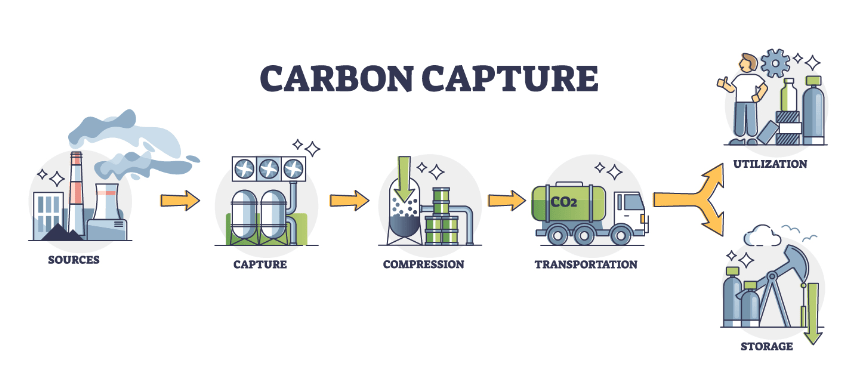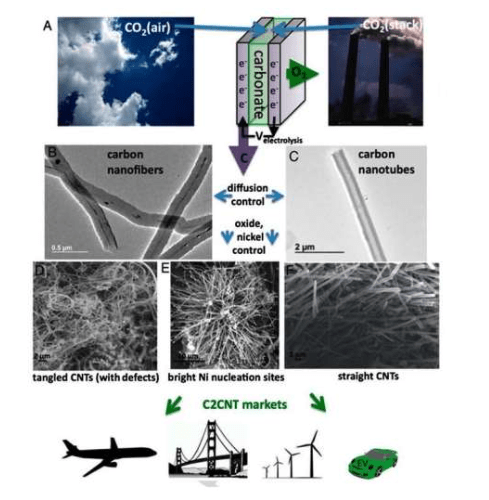Nanoparticles Usage in Carbon Capture Technology
Nanoparticles are being used in carbon capture technologies to improve their efficiency and reduce their cost. Nanoparticles have a high surface area to volume ratio, which gives them a high capacity for absorbing CO2.
They can also be modified to have specific chemical properties that make them more effective at CO2 capture. Some different methods are applied in carbon capture technologies, which are mentioned in detail in the article. However, more research is needed to develop and commercialize nanopartice-based carbon capture technologies. Discover Nanografi's nanoparticle products designed to enhance the efficiency of carbon capture technologies and start using them today to increase your environmental effectiveness!
Introduction
As the urgency to combat climate change intensifies, the scientific community has been pioneering advanced technologies to reduce CO2 emissions. One such groundbreaking approach harnesses the unparalleled properties of nanoparticles in carbon capture technologies. With their high surface area to volume ratio and modifiable chemical properties, nanoparticles present a promising avenue to revolutionize carbon capture efficiency. This article delves into the intricate role of nanoparticles, exploring their mechanisms, innovations, and future prospects in transforming the realm of carbon capture and ultimately, our environmental future. Dive in to understand the nexus between nanotechnology and our sustainable journey towards a low-carbon world.
What is a Carbon Capture Technology?
Carbon capture technologies are a set of technologies designed to capture carbon dioxide (CO2) emissions from industrial processes and power generation sources. They aim to prevent CO2 from entering the atmosphere and either store it underground or utilize it in various applications. Key components include capture methods, transportation, storage in geological formations, and utilization in processes like enhanced oil recovery and carbonate mineralization. Carbon capture technologies are a set of technologies designed to capture carbon dioxide (CO2) emissions from industrial processes and power generation sources. Their development and adoption are vital for achieving net-zero emissions and addressing the challenges of climate change.

Figure 1. Summary of the Carbon Capture Technology process.
Carbon Capture and Storage Enhanced by Nanotechnology
Carbon Capture and Storage (CCS) stands out as a crucial solution in combatting climate change driven by escalating carbon dioxide (CO2) emissions. Nanotechnology emerges as a transformative force, supercharging CCS capabilities. Notable nanomaterials like metal-organic frameworks and carbon nanotubes substantially amplify CO2 capture efficiency. These advancements excel in post-combustion capture, ensuring a larger retention of CO2. Nanomembranes revolutionize membrane separation in CCS, promoting optimal CO2 differentiation and separation. Moreover, nanocatalysts assist in converting captured CO2 into beneficial products. The storage of captured carbon is also a vital part of this process, and nanotechnology paves the way for further enhancements in storage techniques. Together, nanotechnology and CCS promise a hopeful trajectory towards a sustainable environmental future.
Nanoparticles in Carbon Capture
Nanoparticles are instrumental in enhancing carbon capture processes through several key mechanisms. Their high surface area, tunable surface chemistry, and efficient mass transfer capabilities increase CO2 capture efficiency and selectivity. Additionally, nanoparticles play a significant role in direct air capture, catalytic conversion, gas separation, and real-time monitoring. These mechanisms collectively contribute to more effective carbon capture technologies, crucial for mitigating CO2 emissions and addressing climate change.
Definitions and importance
These are a set of technologies and processes designed to mitigate climate change by capturing carbon dioxide (CO2) emissions from industrial and energy-related sources, preventing their release into the atmosphere, and safely storing them underground or utilizing them in various applications. These processes are crucial for reducing the concentration of CO2, a major greenhouse gas, in the atmosphere, which is essential for combating global warming and its associated impacts.
CCS (carbon capture, sequestration, and storage) is vital for combating climate change by capturing CO2 emissions, enabling cleaner energy use, supporting renewables, reducing industrial emissions, and helping achieve global climate goals. It plays a key role in creating a more sustainable and low-carbon future.
Current methods and challenges
Current methods of carbon capture, sequestration, and storage (CCS) include post-combustion capture, pre-combustion capture, oxy-fuel combustion, direct air capture (DAC), and enhanced oil recovery (EOR). These methods are crucial for reducing CO2 emissions from industrial and energy sources. However, CCS faces challenges such as high costs, energy consumption, storage integrity, regulatory issues, public acceptance, scale-up, carbon pricing, and competition from alternative technologies. Overcoming these challenges is essential for the successful deployment of CCS as a climate change mitigation strategy.

Figure 2. The gain of Co2 gasses while carbon capture process.
Integration of Nanoparticles into Carbon Capture Technologies
Existing carbon capture technologies encompass various technologies and projects designed to capture carbon dioxide (CO2) emissions from different sources. Notable examples include post-combustion capture at the Boundary Dam facility in Canada, pre-combustion capture at Petra Nova in the United States, and oxy-fuel combustion tests at the Callide Oxyfuel Project in Australia. Direct air capture initiatives like Climeworks in Switzerland capture CO2 from ambient air, while projects like the Weyburn-Midale CO2 Project in Canada focus on enhanced oil recovery with captured CO2. The Northern Lights Project in Norway addresses industrial emissions by storing CO2 in the North Sea. Research institutions and companies globally are also exploring innovative CCS technologies, and policy-driven initiatives support CCS adoption, highlighting ongoing efforts to combat climate change through carbon capture and storage.
Nanoparticles, including carbon nanotubes (CNTs), mesoporous carbon materials (MCMBs), graphene-based materials, and silica-based nanoparticles, are integral to carbon capture technologies. They enhance the efficiency and selectivity of these technologies by offering high surface areas and tunable properties. CNTs and MCMBs are effective adsorbents with large capacities, while graphene-based materials provide unique structural properties for adsorption and gas separation. Silica-based nanoparticles, with tailored surface chemistries, boost CO2 solubility and absorption efficiency in solvent-based capture processes. These nanoparticles play a pivotal role in improving carbon capture technologies, contributing to the mitigation of CO2 emissions and efforts to combat climate change.
Advancements and Innovations Enabled by Nanoparticles
Nanoparticles have spurred significant advancements and innovations across numerous fields. They enable targeted drug delivery, enhance cancer treatment and diagnostics, improve energy storage and solar cells, aid in water purification and catalysis, strengthen materials, miniaturize electronics, contribute to environmental remediation, and enhance food technology and textiles, among other applications. The unique properties of nanoparticles, such as their high surface area and tunable characteristics, make them versatile tools for addressing complex challenges and driving progress in science, technology, and industry.
Carbon Nanotube (CNT) in Carbon Capture
Carbon nanotubes (CNTs) offer numerous properties and benefits for carbon capture applications. They possess a high surface area, tunable pore size, and chemical stability, making them efficient at capturing CO2. CNTs also exhibit rapid adsorption and desorption kinetics, can be regenerated and reused, and have high mechanical strength. Their compatibility with various capture methods and potential for scalability make them versatile materials for carbon capture. However, addressing production costs and aggregation issues is essential for maximizing their potential in practical applications.
Mesocarbon Microbeads (MCMB) Graphite in Carbon Capture
Mesocarbon microbeads (MCMBs) offer a range of properties and benefits for carbon capture applications. They possess a high surface area, porous structure, and excellent chemical and thermal stability, making them effective at capturing CO2 efficiently. MCMBs also exhibit rapid adsorption and desorption kinetics, are regenerable, and can be tailored for selective CO2 capture. Their compatibility with various capture methods, scalability, and potential for sustainable sourcing make them versatile materials for carbon capture. However, addressing production costs and aggregation challenges is essential for maximizing their practical utility in carbon capture processes.
Graphene-Based Materials in Carbon Capture
Graphene, with its exceptional properties, holds promise in carbon capture applications. It offers a high surface area, tunable pore size, excellent mechanical strength, rapid adsorption and desorption kinetics, and compatibility with various capture methods. These qualities make it an attractive candidate for efficiently capturing carbon dioxide (CO2). Researchers are actively working to overcome production costs and aggregation challenges to unlock graphene's potential for more effective and cost-efficient carbon capture technologies.
Silica-Based Nanoparticles in Carbon Capture
Silica-based nanoparticles, particularly mesoporous silica nanoparticles (MSN), offer several properties and benefits for carbon capture applications. These nanoparticles have a high surface area and tunable pore size, providing efficient CO2 adsorption and selectivity. They exhibit excellent chemical stability, scalability, and compatibility with solvent-based capture technologies. Silica-based nanoparticles can be customized and functionalized for various carbon capture methods and some are regenerable, contributing to cost-effectiveness. Researchers continue to work on addressing challenges like particle aggregation to maximize their potential in practical carbon capture applications.
Conclusion and Future Prospects
Nanoparticles play a crucial role in optimizing carbon capture technologies due to their unique properties, such as providing a large surface area for CO2 adsorption and selective capture capabilities. Their regenerability further adds to the cost-effectiveness and versatility in various carbon capture techniques. In the quest to address climate change, the future trajectory of research in nanoparticle-enhanced carbon capture will revolve around innovating materials, ensuring scalability, evaluating environmental impacts, and fostering global collaborations. The overarching aim is to broaden carbon capture applications and integrate them more seamlessly into various sectors, thereby cementing the significance of nanoparticles in reducing greenhouse gas emissions.
Nanografi continues to enhance the quality of your research and projects with its high-tech products. To get to know us better and explore our products, visit our website.
References
A new approach to carbon capture | MIT News | Massachusetts Institute of Technology. (n.d.). Retrieved January 26, 2024, from https://news.mit.edu/2020/new-approach-to-carbon-capture-0709
Carbon Capture Technology & Converting CO2 into Something Useful - Labtag Blog. (n.d.). Retrieved January 26, 2024, from https://blog.labtag.com/carbon-capture-technology-converting-co2-into-something-useful/
CO₂-removal News : Carbondioxide Removal. (n.d.). Retrieved January 26, 2024, from https://carbondioxide-removal.eu/news/
Langie, K. M. G., Tak, K., Kim, C., Lee, H. W., Park, K., Kim, D., Jung, W., Lee, C. W., Oh, H. S., Lee, D. K., Koh, J. H., Min, B. K., Won, D. H., & Lee, U. (2022). Toward economical application of carbon capture and utilization technology with near-zero carbon emission. Nature Communications 2022 13:1, 13(1), 1–10. https://doi.org/10.1038/s41467-022-35239-9
Ren, J., & Licht, S. (2016). Tracking airborne CO2 mitigation and low cost transformation into valuable carbon nanotubes. Scientific Reports 2016 6:1, 6(1), 1–11. https://doi.org/10.1038/srep27760
Xu, M., & Qiao, Y. (2012). Advanced technologies for coal and biomass utilization. Asia-Pacific Journal of Chemical Engineering, 7(SUPPL. 2), S167–S170. https://doi.org/10.1002/APJ.1621
Recent Posts
-
MXenes from MAX Phases
MXenes, a group of two-dimensional materials derived from MAX phases, are gaining significant tracti …19th Oct 2024 -
Preserving History with Graphene's Power
Cultural artifacts are at risk of deterioration over time due to the destructive effects of both na …11th Oct 2024 -
The Role of Graphene in Neuroelectronics
Neuroelectronics is an interdisciplinary field that aims to develop devices that can interact with t …4th Oct 2024






